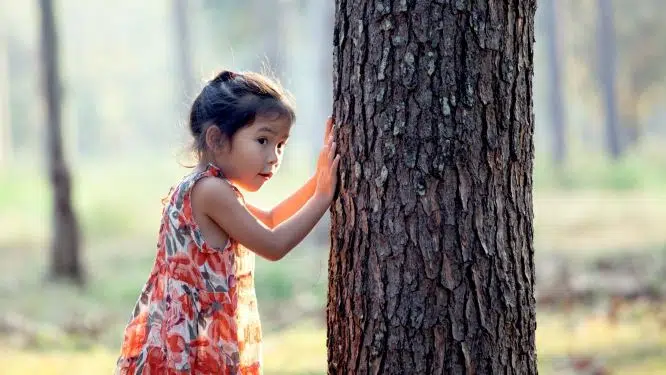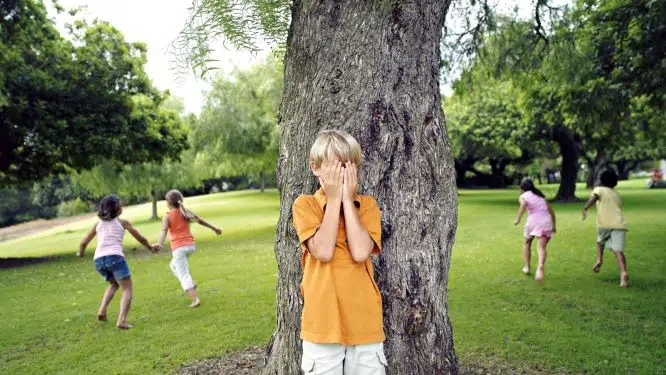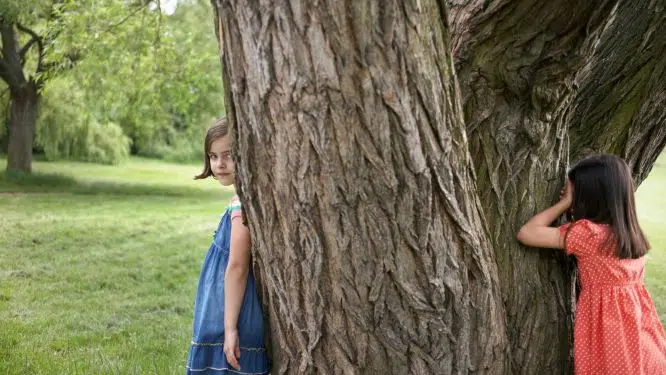Everyone knows the classic children’s game ‘Hide and Seek’, but did you know there are at least 15 variations that children will be able to understand very easily, and that they will quite simply love to play.
I have taught children from the ages of 3 to 5 over the last ten years, and in that time I have tried on many occasions to harness the power of ‘Hide and Seek’ by showing children how to play different versions of this wonderful game. This can develop so many skills.
Research suggests there are many cognitive and emotional benefits to playing hide and seek. (source)
Also these are games that they can play over and over again, developing social skills and positive relationships with others as they play them.
I’ll give a full rundown of these fantastic fifteen games, so that you can start playing them either at work or at home.
A hide and seek game can take place pretty much anywhere – indoors, outside, in the park – you name it!
OK – here we go!
1. Hide And Seek (Standard)
It probably needs no introduction this one, but just for the record, here we go…
One person is ‘on’. They stand somewhere and count to a specified number. Everyone else goes to hide.
Then the person that is on says ‘Coming to find you!’ and goes to find them.
When you are found, you go to a waiting point until everyone else is found.
This game taps into the enthusiasm children have for an element of danger, and of feeling lost or hidden temporarily. Hide and seek is form of risky play, where children get to experience being lost. This gives them a thrill. (Check out my ultimate guide to 25 examples of risky play here.)
2. Hide and Seek Team Up
This is another way that the standard game is often played.
You start the same way, with one person counting and the others hiding. The only difference is that when the ‘seeker’ finds a child, they both now team up to find the rest.
The major tactical difference in this game is when you are hiding you don’t want anyone else that is a hider to see where you have chosen.

3. Sardines
This is kind of like hide n seek game in reverse.
Just one child is hiding in this game, and all the others are seeking.
That child hides whilst the others count with their eyes closed. Then the children all scatter, searching for the child that is hiding.
If one child finds the person hiding, then they join them in their hiding position.
When the next person finds the two hiders together, they also join them. Continue like this.
In the end you will have pretty much everyone lying or sitting next to each other, squashed up like sardines in a can. A great game for team bonding!

4. Secret Wave
This is a fun variation of classic ‘hide and seek’.
One child is the ‘seeker’, closes their eyes and counts.
Everyone else is hiding.
The seeker goes off to look for the others, and when they find anyone, that person will join them on the seeking team.
However, here’s the twist. If the new ‘seeker’ is able to spot another child that is hiding before the main seeker sees them, then the two children (seeker and hider) can do a secret wave to each other.
As long as the original seeker does not see this, the child that was hiding to begin with can now run away and hide once again.
If the ‘seeker’ sees the person hiding doing a wave, however, then they are found and come and join the seeking team. The game ends when everyone is found.
5. Hide And Seek Jail
This is another one that they really enjoy.
One child is ‘it’. They are going to be doing the counting. They count next to a designated spot that will also be the ‘jail’. It could be a tree or next to a fence, for example. If you are indoors, it could be a particular room in the house.
Everyone else goes away to hide.
Whenever the seeker finds someone, they have to go and stand in the ‘jail’.
The aim for the ‘seeker’ is to get everyone into the jail. Then they have won.
However, children that are hiding can ‘free’ people in the jail by sneaking over to the jail and tagging anyone in there. They can then all run away and hide again.
As long as the seeker doesn’t see this, then everyone is back in the game.
There are all sorts of benefits to ‘risky play’ such as this that you can read about in this article that I wrote.
6. Everyone Is On!
This is a simple idea. It’s one against many!
One person hides, and a whole team of people try to find them. Older children (probably from about 6 upwards) could have some kind of timer for this game, and time how long it takes to find them.
Then someone else could have a go of hiding. Keep taking in turns, and see who is able to hide for the longest.
7. Blocko
This was probably the number one hide and seek game when I was a child that we played pretty much daily.
One child is counting, and the others hide. The ‘seeker’ is going to count at a designated spot (such as a tree or fence again). This is the spot that the others are going to try to get back to.
The ‘seeker’ goes off to find the hiding children.
They are all going to try to sneak back and touch the spot (such as the tree) and shout ‘Blocko!’ If they do, then they are safe.
The ‘seeker’ is going to try to tag all the other children. If you are ‘tagged’ then you are out.
It’s basically a sneaky race back to the ‘blocko’ spot.
8. Water Pistol Hide And Seek
This one is definitely not for the faint hearted, and I’d probably only try this with older children.
It’s very simple really. Everyone has water pistols. The water pistols my own kids love are the mighty Super Water Guns! (check out the latest price on Amazon here.) We have had hours of fun in the garden with them.
In the water pistol Hide and Seek game, there is probably one seeker, and everyone else hides.
The seeker is trying to find and fire water at the children hiding, and those hiding will be firing their water pistols back at the ‘seeker’. It’s as simple as that.
You could play several other types of these variations with water pistols.
You could play ‘blocko’ or ‘sardines’ for example, and just fire water at each other as part of the rules!
9. Hide And Seek Move
This is just quite a subtle variation on the main rules of ‘hide and seek.’
Usually, of course, you can’t change hiding places and just stay in one place.
However, in this game, as you can probably guess from the name, you are allowed to move about.
So you might start behind a tree, then sneak over and hide behind a bin when the ‘seeker’ isn’t looking. It’s really as simple as that.

10. Kick The Can
This game requires an empty can, as you can probably guess.
This is a really classic children’s game, that has been played in streets and parks for generations.
One child (or you could have several) is ‘it’ and they close their eyes and count. The can is on the ground near to where they are counting.
All the children hide.
The ‘seeker’ then goes to try to find the children that are hiding.
If the seeker finds someone they can ‘tag’ them and send them to jail.
The aim for the children hiding is to ‘kick the can’. If anyone manages to kick the can, then everyone who is currently in the jail is back free again. Keep going until everyone is in jail.
If you haven’t got a can, then you could use something like a stick, or maybe a pine cone. Using simple loose parts like this as part of outdoor games is so simple and economic. For lots more outdoor loose parts ideas, then check out my in-depth article here.
11. Hide The Teddy
There are many ways of trying this variation of hide and seek.
One way is to have two teams. One team will be seeking, and they close their eyes. The other team will be doing the hiding.
Every member of the hiding team needs to have one toy or teddy to try to hide each.
They go off and hide them and then come back to where the seekers have their eyes closed and say, ‘Ready!’
The seekers go off and try to find the teddies (or toys).
When they have found them all, simply swap roles, and the hiders become the seekers and vice versa.
Another way of doing the game, is that one child does the hiding of the teddy, and everyone else is seeking. The winner is the person that finds the teddy first.
You could also try this game with some kind of class puppet.
12. Hotter/Colder
This is another well used device to incorporate into a hide and seek game.
You probably need one person hiding in this, and one person seeking. There will be at least one other child (though it could be a few) that are going to say ‘hotter’ or ‘colder’.
It’s a simple idea. When the seeker is getting close to the hiding place of the child then you say ‘hotter’. When they move away from it say ‘colder.’
You can spice it up by saying things like ‘You’re getting frozen!’ ‘Super freezing!’. ‘Red hot!’ and all that kind of thing, if the child is getting really close, or extremely far away.
You can also use this device for the hide the teddy game. Hide a teddy, and give instructions as to whether a seeker is getting hotter or colder.
13. Code Hide And Seek
This is a slightly trickier game, that is probably for children from the ages of about 6 upwards.
Have some kind of ‘code’. This could be a laminated word that has been cut into its letters. For example, the word ‘gold’ could be split into four letters ‘g’, ‘o’, ‘l’, and ‘d.’
At least one child is going to be ‘it’ and count, although you could definitely have several. At least one child (but again it could be a few children) will hide the code letters.
The seekers go off and find the ‘code’. When they find it, they try to put it together.
You could potentially have code that is one of the following:
- Numerals from a long number
- Words that make a sentence
- Letters from a name
- Letters from a secret word
14. Object Hunt
This is a similar idea to ‘find the teddy’.
There are two teams again – one the seekers and the others are hiding the objects.
It’s good to have a range of interesting objects for this. It could be some pebbles with pictures on. Or maybe some pretend treasure.
Or it could be toy superheroes, or vehicles, or something else like that which the children are interested in. Tapping into interests is one of the best ways of motivating young children.
Anyway, one half of the children go off to hide them, and then the others go to try and find them.
Finding an object is usually harder than finding a person, so games like this can take quite a bit longer. Objects don’t move, and so they are harder to spot. They are also a lot smaller, and can hide in a wider range of places.
Use a game like ‘hotter, colder’ if they are having lots of problems in finding the objects.
Then, when everything is found, swap roles, and the seekers become the finders.
15. Using Maps To Find ‘Treasure’
This is a game that mixes up the fun of hide and seek, with a bit of early writing and map making.
It’s similar to the hiding objects game above, only it is a longer process.
Split into two teams, the seekers and hiders.
The seekers close their eyes, and (just to warn you) they will probably have them closed for quite a while.
The hiders go hide objects in different places, then they come back and draw a big map as a team of where they’ve hidden the things.
For example, if you hide a digger truck next to a tree, try to draw the tree with a truck next to it! It’s probably quicker if all the hiders work together to draw the map at the same time.
Then the seekers open their eyes, and try to use the map to find the objects.
If they are having problems, the hiders can give them clues, or maybe just explain what the pictures are meant to represent!
This game is a fantastic way of bringing early writing to life!
101 Games Books
Many of the games included in this article are taken from series of 101 Games For Children books.
In particular, there are several hide and seek games in my bestselling book ‘101 More Games To Play Whilst Socially Distancing.’ You can check this book out on Amazon here – Find it on the US Amazon, Find it on the UK Amazon.


Mariana
Wednesday 10th of January 2024
I'm going to try to play the games with my friends because I thought the variations that I didn't know were really cool.